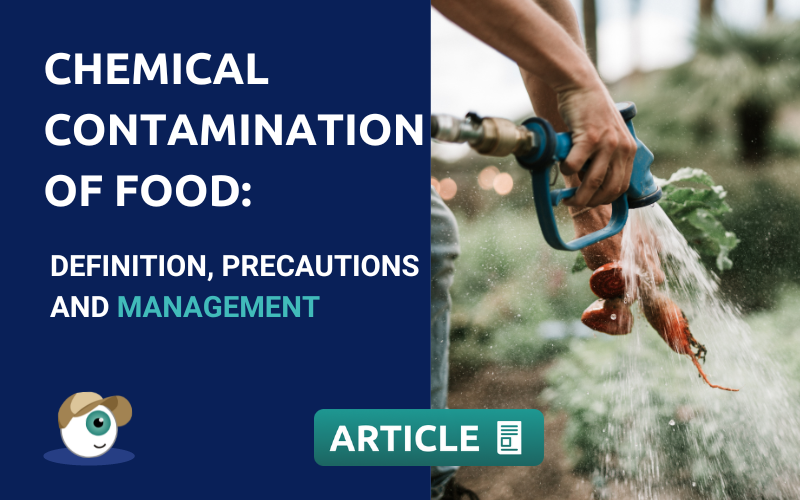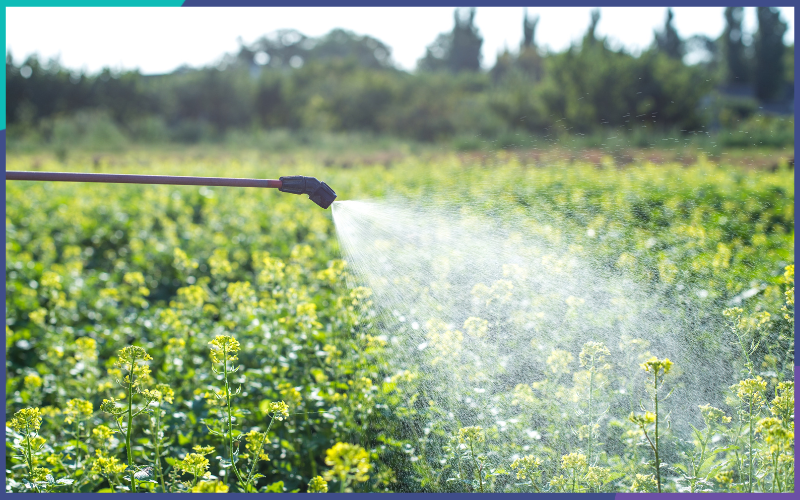Chemical contamination of food: definition, precautions and management
Did you know that food chemical contamination is one of the main hazards to food safety in the food industry?
The presence of an unwanted chemical in our food is much more common than we imagine, and it can enter the food chain system at any point if it is not properly controlled.
Food chemical contamination in restaurants, supermarkets, nursing homes, schools, hotels, hospitals, etc. poses a major risk to the health of consumers, as it can have both acute and chronic effects, both immediate and long-term.
In this article, we share everything you need to know about chemical contamination of food, precautions you can and should take to prevent it, and management practices in the unfortunate event that it happens in your kitchens.
Chemical contamination of food: What is it?
Food chemical contamination refers to the presence of toxic or harmful chemicals in food that can be detrimental to human health. These chemicals can come from sources such as pesticides, industrial chemicals, heavy metals, plastics, and other pollutants.
Chemical contamination of food can be caused by a variety of factors, including poor agricultural practices, water and air pollution, soil pollution, and exposure to chemicals during food processing and preservation.
What are food chemical contaminants?
Food chemical contaminants are toxic or harmful substances that may be present in the foods we consume.
These contaminants can enter foods through soil, water, and air pollution, or they can be released during food processing and preservation. Prolonged exposure to these contaminants can have negative health effects, including chronic diseases and cancer.
Many chemicals are considered food contaminants, the following are just a few examples:
Pesticides: These are chemicals used in agriculture to protect plants from pests and diseases. If not properly controlled, they can contaminate food and be harmful to human health.
Heavy metals: Lead, mercury, and cadmium are heavy metals that can contaminate food through water and soil pollution. These metals can be toxic at high levels and cause health damage.
Persistent organic pollutants (POPs): These toxic compounds, which include chlorofluorocarbons (CFCs) and polychlorinated biphenyls (PCBs), can persist in the environment for many years and contaminate food.
Food additives: Some food additives, such as artificial colors and preservatives, can be harmful to health if consumed in large quantities.
Microorganisms: Bacteria, viruses, and fungi can contaminate food and cause illness.
Chemical contamination of food: common sources
As mentioned, our food system can be contaminated from a variety of sources, ranging from raw ingredients to processing methods, packaging materials, and agricultural products.
Here are some of the most common sources of chemical contamination of food:
Raw materials: Some chemical contaminants can be produced by living organisms in the environment. For example, plants can produce chemicals as a defense mechanism, and when consumed in large quantities, they can cause digestive, neural, and immune system problems.
Agricultural practices: Another source of food contamination can be agricultural practices and operations during the production of raw materials. The unregulated use of pesticides, fertilizers, antibiotics, and other veterinary drugs can significantly contaminate soil, irrigation sources, food crops, and animals, and leave residues in the final raw material used for food preparation.
Food processing facilities and methods: Unintentional chemical contamination can occur within food processing lines. Foods exposed to machine processing can sometimes become contaminated with food processing contaminants, such as lubricants and oils used in equipment maintenance. Additionally, drinking water can also be contaminated by leaks in the piping system.
Improperly disposed cleaning solutions or chemicals in contact with food on equipment and surfaces. It is important that the design of food processing lines take into account critical limits and maximum levels to prevent the production of toxic byproducts, and that it ensures a hygienic design for cleaning and disinfection of surfaces.
Packaging materials. Some types of packaging materials and polymers pose significant risks to human health and can become a source of food contamination. The packaging material used to contain food should be as inert as possible or not react with the attached food. For example, some studies have shown how acidic foods can react with galvanized metal containers and produce unwanted inorganic or organic compounds.
When not regulated, chemical compounds from food packaging, such as metals, aromatic hydrocarbons, melamine, and plasticizers, can migrate to the foods they store. Frequent or daily exposure to food packaging migrants can cause cumulative effects on human health.
Intentional adulteration: In some cases, certain individuals or groups of people deliberately contaminate food production as a form of terrorism or sabotage. This intentional adulteration can lead to health problems and far-reaching problems for any food business.
Such was the case of the 2023 “Sushi Terrorism” which saw Japan’s conveyor belt restaurants grind to a halt, after after a video showed a diner placing a cigarette butt in a container of pickled ginger and another licking the open top of a communal soy sauce bottle and rubbing saliva on passing food.
¿Qué síntomas puede generar la contaminación química de los alimentos?
In a survey about food and public health published in 2021, consumers ranked the presence of chemicals in food as one of their top concerns in terms of food safety.
And it’s no wonder.
The symptoms of chemical contamination of food can vary depending on the type and amount of contaminant present, as well as the individual susceptibility of each person.
However, they are never pleasant, and they can become critical.
Some of the most common symptoms include:
- Nausea and vomiting
- Diarrhea
- Abdominal pain
- Headache
- Fatigue
- Difficulty breathing
- Skin irritation
- Problems with concentration and memory
In severe cases of exposure to chemical contaminants, symptoms such as seizures, kidney and liver failure, anemia, and neurological damage may occur.
Long-term exposure to chemical contaminants in food can also increase the risk of chronic diseases such as cancer, cardiovascular disease, and neurological disorders.
That’s precisely why it’s so important to take steps to ensure food safety and reduce your exposure to any type of chemical contaminant.
What precautions can foodservice businesses take to prevent the chemical contamination of food?
There are many precautions that any business in the restaurant and/or foodservice sector can take to avoid the chemical contamination of its food and ensure the food safety of its customers:
- Buying quality ingredients: It is important to make sure that the ingredients purchased are of high quality and free of contaminants, working with reliable suppliers and verifying the traceability of food.
- Proper food storage: Foods must be stored in a safe and controlled environment to avoid contamination. This includes storage at the appropriate temperature and separation of raw and cooked foods.
- Proper food handling: It is important to ensure that workers in the restaurant practice proper hygiene when handling food, including frequent hand washing and separation of raw and cooked foods.
- Use of clean kitchen equipment and utensils: Kitchen equipment and utensils must be washed and disinfected properly before use.
- Pest control: It is important to control pests in the restaurant to avoid food contamination. This includes monitoring and controlling rodents, insects, and other animals.
- Employee training: Employees must be trained on how to prevent chemical contamination of food and how to ensure food safety.
These are just some of the precautions that foodservice businesses can take to prevent the chemical contamination of food. Implementing these measures and taking additional steps to ensure food safety is essential to protect the health of customers and maintain the integrity of the restaurant brand.
How can technology help prevent the chemical contamination of food?
Technology can help prevent chemical contamination of food in several ways:
- Real-time monitoring systems: These systems use technologies such as sensors and detection devices to continuously monitor the food content and detect any presence of chemical contaminants.
- Laboratory analysis: Laboratory analysis technology, such as mass spectrometry and chromatography, can help identify chemical contaminants in food and determine their concentration.
- Quality control systems: Quality control systems, such as temperature monitoring systems and supply chain tracking systems, can help identify critical points in the food production process and ensure that quality standards are met.
- Packaging and packaging technology: Packaging technology, such as intelligent packaging and biodegradable materials, can help reduce exposure of food to chemical contaminants and improve food integrity.
- Mobile applications: Mobile applications, such as supply chain tracking applications and food analysis applications, can help improve transparency and efficiency in food production and prevent chemical contamination.
While technology is a valuable tool for preventing chemical contamination of food and improving food safety, it is important to remember that technology alone cannot solve the problem of chemical contamination of food. An integrated approach is needed that involves all actors in the food supply chain, from producers to consumers.
How can food safety digital assistant Andy help prevent the chemical contamination of food?
Andy, is a leading food safety management software used worldwide by the big names in the industry from Starbucks, to Domino’s Pizza, NewRest, and many, many more!
All of them use Andy to guide their kitchen teams in a friendly and intelligent way, preventing, caring, and ensuring that quality work is done in the shortest possible time.
Andy digitises all the actions related to food safety processes, traceability, labeling, and workplace hygiene, significantly reducing the time the team spends on them, and facilitating the perfect compliance with all mandatory HACCP and Hygiene records.
For supervisors, the control and compliance processes for action plans in any of the chain’s establishment are just a matter of logging in, looking at what’s been happening, and taking the necessary action, thus avoiding any type of risk associated with chemical contamination (or other types of contamination) of food.
The following are just some of the tasks Andy can help staff ensure their kitchens are safe and free of risks to consumer health.
1. Digital HACCP
Andy digitises cleaning and hygiene records, maintenance, temperatures, and any necessary checklist, ensuring that they are always in compliance with the law.
Thanks to the digitization of HACCP with Andy, all mandatory records can be met while also activating corrective plans automatically, streamlining operations – from taking temperatures to implementing corrective actions, setting acceptable limits, and the frequency of surveillance.
Andy guides teams and ensures that procedures are carried out correctly and always on time.
👉Continue reading about Digital HACCP with Andy👈
2. Incident Management
Andy automates any incident that occurs in a commercial kitchen with simple and effective corrective plans.
Andy has the power to help resolve any discrepancies that arise and activate the right action plan to address them in a fraction of the time that kitchen teams typically invest.
Through an effective notification system, any incident is resolved in record time!
👉Find out more about incident management with Andy👈
3. Internal Communication
Andy facilitates internal communication efficiently through its internal chat.
A secure environment from which to transmit information in document, video, or even image format that can be found in the Andy resource library.
4. Internal Audits
With Andy’s integrated audit plan, you can control participant access, customise scores, and collect all inspections in one place.
👉Find out more about automating your audits with Andy👈
5. Food Labelling
One of Andy’s key functionalities is the labelling of products and ingredients in a much faster and easier way, ensuring greater food safety in all types of kitchens.
👉Find out more about food labelling with Andy👈
Any measure taken to prevent and manage cross-contamination and other food safety risks in commercial kitchens is a welcome and well-applied measure that will have a positive impact on the health of consumers and the brand.
Why not try the many advantages that the leading food safety digital assistant can offer to your business?




